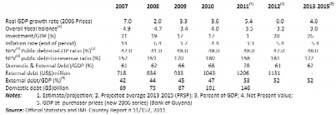My last two Sunday columns elaborated on the proposal for a Budget Office to be established in the National Assembly (NABO). This not only offers a unique opportunity to restore public trust in official economic data, important as that is, but also to foster the enhancement of the capacity of the National Assembly to contribute meaningfully to annual budget preparation; oversight of economic and financial governance; and proper performance evaluation and reporting on national economic and financial matters. In this way it is proposed the National Assembly will be institutionally strengthened, thereby reinforcing the separation of powers in Guyana’s political-constitutional system, which has been overwhelmingly driven by executive overreach and lawlessness.

Starting point
Persons with the slightest familiarity of recent international economic developments would recognize from news reporting on countries as widely different as China, India, the United States, Europe and a host of developing countries in Africa, Asia, and Latin America and the Caribbean that budgetary concerns, apprehensions, and fears dominate news reporting on global economic affairs.
At this juncture, whether it is rising import (commodity) prices in China; challenges of export growth in India; national budgetary deficits, debt, and taxation worries in the United States; sovereign debt, banking, and currency risks in European financial markets; or the myriad of concerns over jobless growth, weak export earnings, slow investment and speculation in other countries, no one can deny that macroeconomic postures/stances, and policies, are at centre stage of global economic and financial considerations.
This is made more critical as the global economy faces an uncertain recovery from the Great Recession, which started in late 2007. The lesson I encourage readers to draw from this is that the best way (not the only acceptable way) to engage the Guyana National Budget 2012 is to start with an evaluation of what it implies for the stability of Guyana’s macroeconomy as it goes forward over the medium term. Parenthetically, I might add the National Budget 2012 presentation correctly begins, as all national budgets are expected to do, with a brief survey of pertinent international developments followed by an overview of Guyana’s domestic macroeconomy.
Macroeconomic outlook
To aid this discussion, I have put together in Table 1 several key indicators of the performance of the economy since 2007 and official projections to 2015. In the interest of full disclosure the following important points are brought to readers’ attention.
Table 1: Macroeconomic Performance and Outlook (2015)
First, in all instances I have used official published statistics, despite my earlier criticisms of these. Where other data are used these are sourced from the IMF and World Bank, which in turn cite national authorities as their source. Second, the data series start in 2007 basically because that is the earliest year from which calculations using the new rebased GDP series (2006 base year) can be used to establish annual growth rates. Third, the data which cover 2012 and the outlook average for 2013-5 use published official projections. Finally, I have not included any data sourced from private persons or organizations.
The rebased National Accounts effect
The first point to observe about these performance indicators and projections is the dramatic impact of the rebasing exercise on macroeconomic ratios. One example is that the total (domestic and external) debt to GDP ratio based on the rebased data shown in Table 1 displays moderate debt stress. On average for the years 2007-2011 the rate was 67 per cent.
In an exercise I simulated what the GDP based on the previous (1988 prices) would have yielded for the GDP measures for the period 2010-2011. For the years 2006-2009 I used the simulated data presented by the Bureau of Statistics (2010) as it sought to show the statistical impact of the rebasing on the size of the GDP. I merely extended this for 2010 and 2011.
When the total debt is expressed as a ratio of the simulated GDP based on the previous price series (1988) the dramatic change in the results is summarized below.
Year Total Debt/GDP (simulated)
Ratio (%)
2007 98
2008 103
2009 109
2010 110
2011 127
Average 109
Source: Bureau of Statistics and Author’s Estimates
This discussion demonstrates the potential for painting a rosier picture when the new rebased data are used. To the extent there was data quality improvement equal to the statistical improvement shown, the ratios as given in Table 1 indicate debt stress. If, however, the data quality improvement was less, the debt stress levels dramatically rise.
Nowhere in the National Budget 2012 is this possibility acknowledged. The IMF had made brief reference to this situation in the following observation: “Following the rebasing of GDP in late 2009, debt-to-GDP ratios declined significantly” (IMF, 2010, footnote 5 page 19).
In the coming weeks I shall continue to raise considerations which are likely to threaten macroeconomic stability over the medium term.






